Alexander Binder is prepared to fill it. (Via)
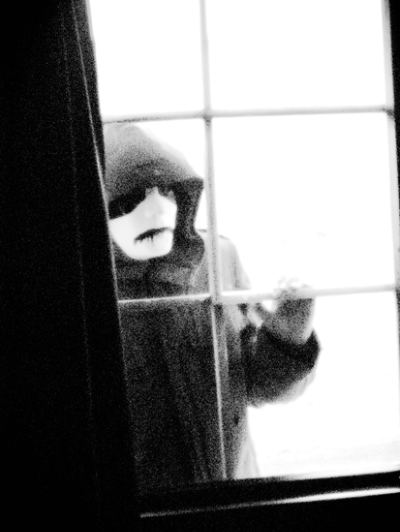
Regina Hackett takes her Art to Go
Alexander Binder is prepared to fill it. (Via)

Two images.
“I am lonely, lonely.
I was born to be lonely,
I am best so!”
from Danse Russe, William Carlos Williams
Marx, from The Eighteenth Brumaire of Louis Bonaparte, 1852:
Men
make their own history, but they do not make it as they please; they
do not make it under circumstances of their own choosing, but under
circumstances existing already, given and transmitted from the past.

Across the street from Rem Koolhaas’ Seattle Central Library is an
anonymous corporate building whose courtyard long sported incongruously
heavy-duty art credentials.
On the southwest corner is Henry Moore’s Vertebrae from 1968, in place since 1971.
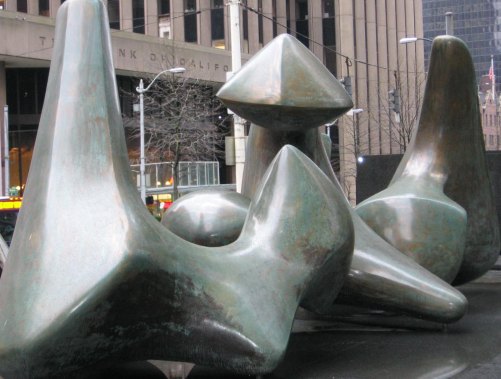 Behind and just north of Vertebrae a large acrylic abstraction by Sam Francis hung in the building’s lobby, fully visible from the street. It’s a grid undermined by splatters of colored light, 18.8 feet high and 26.6 feet wide, created in 1979 and purchased in 1980.
Behind and just north of Vertebrae a large acrylic abstraction by Sam Francis hung in the building’s lobby, fully visible from the street. It’s a grid undermined by splatters of colored light, 18.8 feet high and 26.6 feet wide, created in 1979 and purchased in 1980.
It’s gone now. Bank of America, its current owners, alerted nobody but the building’s tenants. Even they got only two days notice. This email arrived in their collective mailboxes on June 24 from Carsten Stehr, portfolio manager- NW Corporate Workplace,
Bank of America:
We wanted to make you aware that on June 26th, the Sam Francis painting
located in the lobby will be permanently removed to become part of the
bank’s Art in our Communities program and will initially be loaned to
the Mint Museum of Art in Charlotte, NC in conjunction with a large
exhibition of contemporary art from the bank’s collection.
The Francis is a last-minute addition at the Mint. On its website, the Mint doesn’t mention it. Stehr didn’t return several phone calls, but Britney Sheehan, media relations for the bank, did. She noted that instead of occupying several floors of the building, BofA is now limited to part of the lobby. Aside from joining the bank’s exhibit at the Mint, Francis’ painting has nothing else inked on its dance card. I asked Sheehan for an image. The next day, we had the following exchange.
Sheehan: We don’t have an image.
Me: You’ve owned the painting since 1980 and don’t have an image?
Sheehan: Yes.
Me: You can tell me that you won’t send me one, but you shouldn’t say you don’t have one. It isn’t believable.
Sheehan: An image is not available.
Below, a bad image from Google Earth:
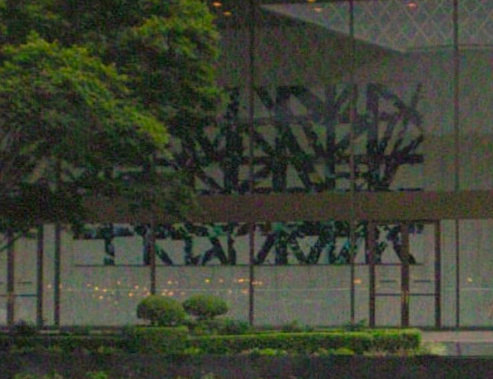 The bank has good reason for not wanting to share. In 1986, Seafirst Bank and JMB Management Company admitted that they had sold Vertebrae to a private collector in Japan. Both Seafirst and JMB were swamped by angry calls.
The bank has good reason for not wanting to share. In 1986, Seafirst Bank and JMB Management Company admitted that they had sold Vertebrae to a private collector in Japan. Both Seafirst and JMB were swamped by angry calls.
Linda Farris and David Mendoza organized protest marches and petitions. (“Henry Moore, he’s our man, we don’t want him to go to Japan.”) Unfavorable press coverage (largely from me) broke out of the arts section and began appearing on the front page. The city stepped in, blocking the sculpture’s removal on a technicality
(work permits were not in order).
After 8 tons of bad publicity over a two-month period, JMB and Seafirst
gave the Seattle Art Museum the money (twice the $1 million they’d received)
to buy back the sculpture from its new owner and guarantee it a
permanent Seattle home.
Will the Francis be sold after its star turn at the Mint? Nobody’s saying. Sheehan emphasized that the bank continues to support the arts in Seattle. She said in 2009 it donated $300,000 to arts in Seattle and Bellevue. In the last 10 years, she noted it has donated $900,000 to ArtsFund.
That’s an admirable past, but the loss of the Francis is a doleful comment on the future.
On the admirable Pacific Standard blog, Strath posted a range of old glories in honor of the Fourth. Below, a few of my lesser-known favorites (beyond Jasper Johns and David Hammons). Also, check out Tyler Green’s flag survey on BuzzFeed.
Meiro Koizumi at Open Satellite:
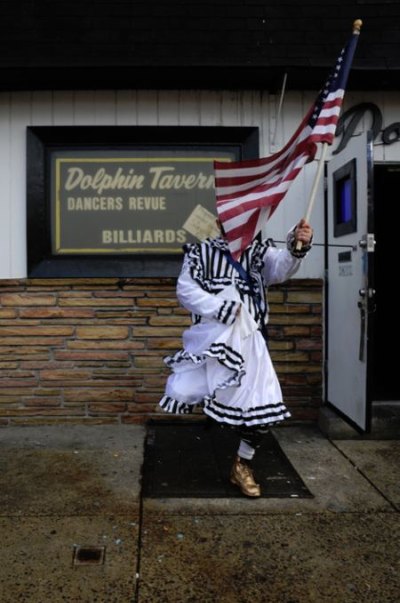 Jack Daws, three times
Jack Daws, three times
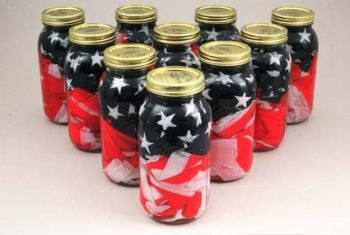

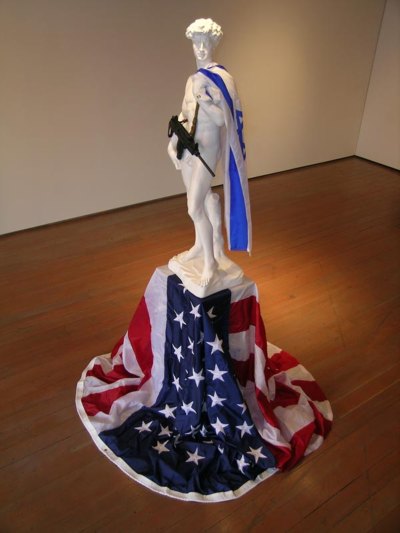 Ross Palmer Beecher, two times
Ross Palmer Beecher, two times


(Image below via)

Allen
Ginsberg – from AmericaAmerica I’ve given you all and now I’m nothing.
America two dollars and twenty-seven cents January 17, 1956.
I can’t stand my own mind.
America when will we end the human war?
Go fuck yourself with your atom bomb.
I don’t feel good don’t bother me.
I won’t write my poem till I’m in my right mind.
America when will you be angelic?
When will you take off your clothes?
When will you look at yourself through the grave?
When will you be worthy of your million Trotskyites?
America why are your libraries full of tears?
America when will you send your eggs to India?
I’m sick of your insane demands.
When can I go into the supermarket and buy what I need with my good
looks?
America after all it is you and I who are perfect not the next
world.
Your machinery is too much for me.
You made me want to be a saint…
America stop pushing I know what I’m doing.
America the plum blossoms are falling…
I sit in my house for days on end and stare at the roses in the
closet…Asia is rising against me.
I haven’t got a chinaman’s chance.
I’d better consider my national resources.
My national resources consist of two joints of marijuana millions of
genitals
an unpublishable private literature that goes 1400 miles and hour
and
twentyfivethousand mental institutions.
I say nothing about my prisons nor the millions of underpriviliged
who live in
my flowerpots under the light of five hundred suns.
I have abolished the whorehouses of France, Tangiers is the next to
go.
My ambition is to be President despite the fact that I’m a Catholic.America how can I write a holy litany in your silly mood?
I will continue like Henry Ford my strophes are as individual as his
automobiles more so they’re all different sexes
…
America this is quite serious…
It’s true I don’t want to join the Army or turn lathes in precision
parts
factories, I’m nearsighted and psychopathic anyway.
America I’m putting my queer shoulder to the wheel.
Norman Rockwell was the great illustrator of mid-20th Century American complacency. His work is a siren call for the right, most recently expressed by Deborah Solomon in the New York Times:
Norman Rockwell’s cheerful America has lately acquired a startling
relevance both inside and outside the art world, in part because it
symbolizes an era when connectivity did not require a USB cable…
Rockwell’s paintings are easy to recognize. In the years surrounding World War II his covers for The Saturday Evening Post depicted America as a small-town utopia where people are consistently decent and possess great reserves of fellow-feeling. Doctors spend time with patients whether or not they have health insurance. Students cherish their teachers and remember their birthdays. Citizens at town hall meetings stand up and speak their mind without getting booed or shouted down by gun-toting rageaholics.
This is America before the fall, or at least before searing divisions in our government and general population shattered any semblance of national solidarity. Rockwell’s scenes of the small and the local speak to us in the age of the global because they offer a fantasy of civic togetherness that today seems increasingly remote.
America before the fall? Maybe. Eve’s apple came from the tree of knowledge. Our fabled first parents were doing fine as long as they stayed stupid. One bite of reality, and the illusion of a garden dissolved. (As for small-town American utopias, there’s more reality in a page from Babbitt than in a roomful of Rockwell’s.)
To be moved by Rockwell requires a willful narrowing. America in the 1950s was a reasonably decent place if you were middle-class, mentally secure, easily amused and incurious about the lives of others. The Civil Rights Movement and the student rebellions it spawned on university campuses burst those bubbles. A half a century later, the right is still trying to reconstruct them. Despite its efforts, we’ve come a long way since racism, sexism and homophobia were the unchallenged backdrop of American life.
Rockwell painted a celebratory version of ignorance. (If I cannot see you, you cannot be you.) The doctor’s never drunk on a home visit, the priest is not fondling the boys, and the father is never flashing his strap. Above all, women know their place, and black people are content to root around in the shadows.
Image via

Solomon:
It is true that (Rockwell’s) work does not acknowledge social hardships or
injustice. It does not offer a sustained meditation on heartbreak or
death. Yet why should it? Idealization has been a reputable tradition in
art at least since the days when the Greeks put up the Parthenon, and
Rockwell’s work is no more unrealistic than that of countless
art-history legends, like Mondrian, whose geometric compositions
exemplify an ideal of harmony and calm, or Watteau, who invented the
genre of the fête galante.
She’s confusing a search for a root ideal with propaganda. To celebrate a fundamental grace, be it in mathematics or the flounce of a lady’s skirt, is not the same as a cover-up. The first shines, the second rots under its false premises. What Candide concluded about the promises of Pangloss is true of Rockwell’s American Dream: ” It is a mania for saying things are well when one is in hell.” It is an inability to recognize that being born into a favored group is not the same as creating favored circumstances.
Rockwell opens tomorrow at the Smithsonian’s American Art Museum.
…stares into his future, which is behind him.
Mike Worrall, (via), painting under the influence.
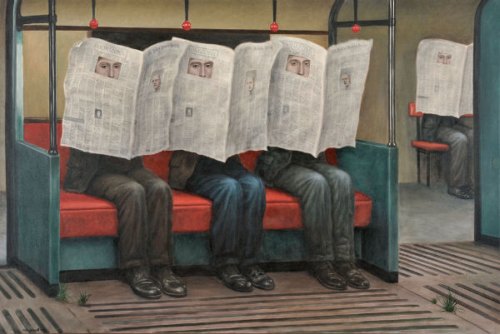
Heading into the fourth episode on Wednesday night, Work of Art: The Next Great Artist has provided a few surprises. Despite a lackluster beginning, auctioneer Simon de Pury has come into his own as a coach, dispensing genuinely helpful advice. On the other hand, Jerry Saltz has yet to emerge. The editing of his remarks has to be brutal.
If this were Saltz before editing:
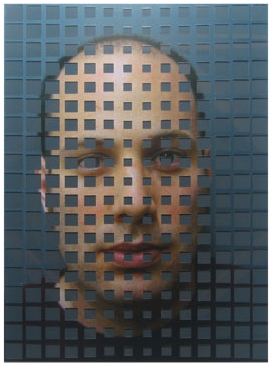 This would be him after:
This would be him after: (Both images details from Drew Daly’s altered photographs via Greg Kucera Gallery)
(Both images details from Drew Daly’s altered photographs via Greg Kucera Gallery)
In my previous post about this show, From
Bravo: the next barely adequate artist, I wrote that the show would depend on Saltz. Wrong. Others have emerged in the forefront, and by that I mean the artists. Out of 14, four shouldn’t be there, and three are gone. (One to go.) The rest are capable of working within the framework of a reality TV show and putting their stamp on it, and I love that they can’t be counted on to stand there and be judged.
Best line from the show still belongs to Nao Bustamante, who told the judges on the first episode, “I’m not responsible for your experience of my work.” On the second episode, artist Miles Mendenhall went further. Refusing to accept that the judges are the only ones whose opinions matter, he joined the panel to offer his own. For making an entirely accurate remark about the work of another contestant, he has drawn ire from critics, naturally enough. Judgments are their job. On Culture Monster, critic David Ng called Mendenhall an “emo-hipster backstabber.” Why? Because Mendenhall said something smarter than anyone else in the room.
Ng also noted that Mendenhall “talks endlessly about his obsessive-compulsive disorder and chronic insomnia.” On this show, it’s impossible to say who talks endlessly and who makes a couple of necessary observations. It’s called editing.
Speaking of chatter, there’s a lot of it currently about OCD. People who are a little distracted claim it, as if it were an honor. Mendenhall has it. Ng appears to have nothing but contempt for the artist, even though he’s moving mountains to make his appearances.
Personally, I’m sad to see someone that young and afflicted struggle with what looks like an untreated disability. Isn’t this the 21st Century? I’m also thinking of Tobias Wong. And I’m thinking of my father, a paranoid-schizophrenic novelist who self-medicated with alcohol and still managed to be both a terrific dad and artist. Such careers are necessarily short. I’d like to think there’s more help out there now, but I don’t see it.
On a lighter note, the excellent Sharon L. Butler (Two Coats of Paint) is hosting her own version of Work of Art on facebook.
an ArtsJournal blog


